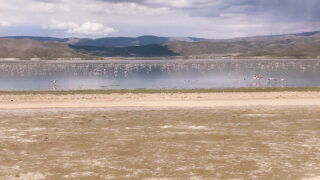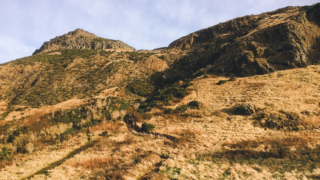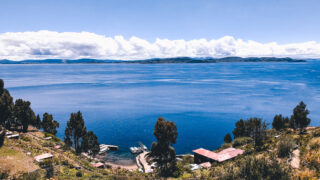Paracas is a pit stop between Peru’s capital Lima and Huacachina for many. Having not heard much about it previously I was surprised by how relaxing of a break the seaside village was after the bustling metropolis. The coastal line of Paracas is incredibly beautiful being graced by desert landscapes, the crystal blue ocean, and orange cliffs. Here I had one of my most memorable morning coffees, having been greeted by dolphins swimming close to the shore. Damn my short legs for not being able to sprint for the empty kayaks fast enough to get closer to the friendly creatures. Isn’t Paracas worth visiting just for that?
Paracas is a peninsula situated on the coast of the Pisco Province. The area you are most likely going to stay in, referred to by everyone simply as Paracas, is the main village of El Chaco. Although the beach and ocean water in Paracas are not the most stunning you can find in Peru, the town makes up for it through dramatic desert landscapes. There are also many different activities to partake in, from paragliding, desert hikes, riding sand-buggies, kayaking, kite surfing, seeing elongated skulls, taking a bike ride through the national reserve; to visiting the poor man’s Galapagos, the Islas Ballestas, to see penguins and blue-footed boobies. Trying to figure out what to do, eat, where to stay, and what on Earth blue-footed boobies are? Read on to find out.
Post Contents
WHY PARACAS IS WORTH VISITING

Visit the Islas Ballestas.
The Islas Ballestas are a small group of islands near Paracas. In case your budget does not allow for a visit to the Galapagos, then Paracas is worth visiting just to head to the islands. Here you can see Humboldt penguins, sea lions, blue-footed boobies, and if in luck even humpback whales. Your best chance to see one of these gentle giants is during whale season between August and October. Unfortunately, the islands cannot be explored by foot, which doesn’t allow you the interaction with the animals that the Galapagos are famous for. But, for a mere S/ 25 – 30 no harm is done in taking a boat tour around the animal invested rock formations.
The earliest departure from the pier in Paracas is at 8 am. Early risers will usually be rewarded with the calmest sea and best animal sightings. Although, anyone travelling during the off-season should be able to even purchase a ticket in the morning. Otherwise every tour operator in town sells tickets in advance. But, be aware that buying a ticket on the street from someone waving laminated pictures into your face could be a scam. Having been to the Galapagos myself I did not end up taking the tour, but it is cheap and feedback I have been given was good. Although, be warned the waters can be rough.

Good To Know Before Visiting Islas Ballestas.
As you might have noticed already, South America loves to exclude taxes from ticket prices, making you frantically run around looking for the tax ticket offices. Well, if you are anything like me and leave ticket purchases to the last minute. If you haven’t visited the National Reserve already you will have to pay the S/ 10 entrance fee.
Bear in mind to keep your entrance ticket if you visit anything within the National Park after. The ticket office is near the port, ask the ticket officer for directions if you cannot find it. There is also a small port fee of S/ 5 to be paid at the pier. Alternatively, if you want to swim with sea lions you can do so by visiting Isla Palomino, which can be reached from Lima.
Shadow Trek.

The Shadow trek was the highlight of my three-day trip to Paracas. The hike is fairly easy, involving only a few short hikes up desert hills. The 3.30 h trip starts at 4 pm, giving you time to explore the Paracas National Reserve beforehand in other ways.
After a short minivan ride to your first stop, you will be walking over millions of white and pink shells to reach flamingo invested waters. From there the guide will lead you through desert landscapes towards a slightly steep hill. This is the only minorly challenging incline during the tour, due to the gritty sand limiting grip. From there on it is all mesmerising ocean views on top of the stunning orange cliffs of Paracas Bay.

On the way to the sunset viewpoint, we even came across a blue-footed booby nest with hungry mouths staring at us. Followed by a rock formation that was incredibly accurately shaped like a turtle.

This trek can currently only be booked through the Kokopelli hostel and costs S/ 80. It is on the more expensive side for a tour that doesn’t include any food, but groups are kept small, and in my opinion, it was worth every penny. At no extra cost, the guide will take many incredible pictures, like the one below.

How to Explore the Paracas National Reserve.
The Different For Visiting Paracas National Reserve.

Still not sure if Paracas is worth visiting? The many ways of how to explore the Paracas Nature Reserve should help you make up your mind. The most fun way to discover these desert landscapes is by sand buggy, ATV, or paragliding. These are also your most expensive options. Sand buggy and AV rides costing around S/ 90, and prices for paragliding being around $70.
Another option is to get some exercise by renting bikes to explore the Nature Reserve on your own. Although you will not be able to cover all there is to see in the reserve. Do none of these options sound right for you? Do not worry there are also one-day tours involving minimal movement. All these activities can be booked with tour operators in town, as always, it is worth comparing prices and details.

Is It Worth Visiting The Paracas National Reserve By One-Day Tour?
Unlike my usual craving for adventure and any excuse for a sand buggy ride, I felt like kicking back and exploring the Nature Reserve by minivan. Don’t judge we all have our lazy days! We were picked up at 9.20 am to be taken to our first stop, a museum. We were given spare time to explore and could take a short walk to look at flamingo invested waters from an afar distance. Surrounded by orange desert mountain landscapes we made our way to the stunning Paracas coastal cliffs where we overlooked the stunning bay. This was followed by the most sought-after destination, Playa Roja. You will be able to marvel over the red beach from the top of the cliffs, as well as the oceanfront.

Our final stop was for lunch at a bay with restaurants and a small beach. You are given an hour here before returning to the village by 3 pm. Bring your own snack if you don’t want to pay for an overpriced lunch. Otherwise, you can bring a bikini and enjoy some beach time watching the penguins sunbathing and jumping off the rocks.
This tour is not the most exciting experience you will partake in during your trip. Although, for only S/ 20 + S/ 10 for the reserve entrance fee, it makes for a cheap, relaxed day activity. Some tour operators, such as Peru Hop, also include the slave tunnels. In hindsight, I think the sand buggy tour is a better way to spend your money, but that might just be me craving adventure.
Kitesurfing, kayaking, or banana boat.

Paracas will never become famous for its beach, but there are a couple of water activities you can dedicate your time to instead. If you stay at Kokopelli you should make use of their free kayak rental. We were lucky enough to be joined by two dolphins.
There are kitesurf schools in the village of Santa Domingo, only an 8-minute taxi ride away from El Chaco where you most likely will be staying. Alternatively, there are banana boat or donut rides offered by locals along the beach.
Paracas History Museum – Juan Navarro Hierro.
Have you been wondering why I mentioned an elongated skull in my intro? There is a museum that showcases several elongated skulls. For S/ 10 you can get some background information on their history.
WHERE TO EAT
Most restaurants can be found on the Malecon by the beachfront. There are a couple of local restaurants offering cheap menu del dia’s and street burgers, otherwise the restaurant prices here aren’t the most backpacker-friendly. Or maybe I am just being stingy.
Restaurante El Ancla.
This restaurant is not the cheapest, but the food is delicious, and we were even offered free Pisco Sours. Who would say no to that for a lunchtime treat?! Malecon El Chaco, Paracas 11550
WHERE TO STAY
Kokopelli.

Paracas is worth visiting for two to three days, and Kokopelli is perfect if you want to spend one of these days just kicking back. This isn’t the cheapest hostel in town, but I would highly recommend staying here. The hostel is a fair walk from the bus stop being on the opposite side of town. But, at least it is easy to find, just walk a straight line right to the end of the village.
Kokopelli is located right on the beach, has a pool, and a bar/ restaurant with activities every night, including karaoke! Anyone else out there owning them Spice Girls songs? The girls’ room even had hair straighteners! To top it all they have kayaks you can use for free. When you leave hold onto your wristband! You can get discounts at different sister branches.

WHAT TO PACK
In this part of the world it never gets much colder than 15 degrees, and unless you visit in winter, May to September, you will only need summer clothes, swimwear, and trainers for your desert adventurous.
WHERE TO NEXT?
From Lima to Paracas it takes four hours with Cruz del Sur and costs
S/ 46, although you should be able to get cheaper with a less prestigious bus company. They were my favourite bus operator in Peru, because of their comfortable seats, reliability, and always having drinks and snacks included in the price.
Headed to the white city of Arequipa? There are night buses for around S/ 90, or you can continue your journey to Peru’s most popular destination Cusco for around S/ 160.
Although you might want to head to desert landscapes in the more traditional sense of sand dunes, which you can find in Huacachina. To get there you need to take a 1.30 h local bus to Ica for S/ 20, they stop on the main road near Kokopelli. From Ica you can take a short taxi ride for S/ 10 or a tuk-tuk for S/ 5. You can also take Peru Hop busses to Lima, Huacachina, and Nazca.

Did I do a good job of sharing my love for this coastal village? Also, did I mention that I love blue-footed boobies? Still no clue what they are? They are white-brown marine birds native to the Pacific Ocean. They can easily be recognised by their, surprise, surprise, their blue feet. The blue feet are this eccentric colour due to their diet and play a big part in their mating ritual.
Now go ahead and explore! Try not to lose your towel.














